The Road To Ramallah, Part Two
But I’m getting ahead of myself, and in any event, I was still trying to remain as neutral as possible. It’s rare in any conflict, isn’t it, for one side to be entirely right and the other entirely wrong? To be honest, over the past 40-some years – the 1967 War being when I first started paying serious attention to Israel, my feelings and loyalties have shifted from one side to the other and back again at least a couple times. No doubt it’s hopelessly idealistic of me, but I’d like to see everybody happily getting along in a basically secular state that allows freedom both of and from religion for all concerned. Like we have here in the good old US of A, right?
One thing I found quite shocking about Jerusalem is how small it is. Not the modern city, whose three quarters of a million inhabitants sprawl for miles in every direction as in any modern exurbia, but the “real” Jerusalem, the actual Holy City over which nations and tribes have been butting heads, spears, and cannons for several thousand years, is confined to the area within the medieval walls of what is now known as the Old City.
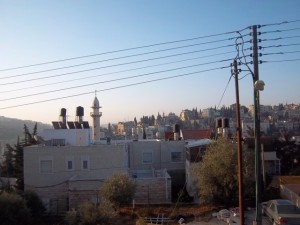
It wasn’t until the 19th century (A.D.) that any significant settlement took place outside the walls, yet this labyrinthine warren, presently occupied by somewhere between 40,000 and 60,000 people, and which could fit comfortably into a corner of lower Manhattan, is the focal point and fulcrum on which civilizations have risen and fallen, and may well again.
When I booked my hotel, I did so mainly on the basis of price, that and proximity to the Old City, which was where I figured I’d want to spend most of my time. It was only later that I realized this meant staying in Arabic East Jerusalem, nominally but not always happily a part of Israel. When I’d mentioned this to Yitzhak in Tel Aviv, his eyes had widened, then narrowed. “Be careful,” he said.
“What do you mean?” I asked. “From everything I’ve heard, Jerusalem is quite safe. Aside from terrorists, of course, but there’s been very little of that these past few years. What should I be watching out for?”
“Nothing,” he said, sounding as though he very much meant something. “Just watch your step.”
I was to meet many Israelis who were extraordinarily liberal in almost every regard except when it came to trusting Arabs. What was especially frustrating about it was that many of them had little or no actual contact with Arabs. It was a case of “they don’t have the same values as us,” with very little in the way of specifics as to what exact values “those people” supposedly did have. “Have you actually been to East Jerusalem?” I’d ask, and from a surprising number of seemingly bright, intelligent people, the answer would be, “Why would I need to go there?”
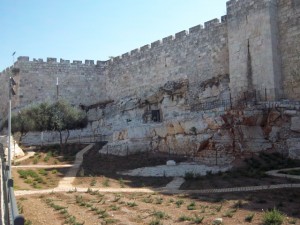
The Old City itself, technically part of East Jerusalem, was the exception; its religious sites, profoundly sacred to Jews, Christians and Muslims alike, and its incredibly colorful street life, which the cynical-minded might describe as the world’s most authentic theme park, attract vast numbers of tourists and West Jerusalemites, although most of them clear out not too much after nightfall, leaving the dark and sometimes undeniably spooky streets to the overwhelmingly – something like 90% – Arabic population.
To the north of the Old City, the neighborhood was also overwhelmingly, almost exclusively Arab, and this was where I was staying, in a quarter called Wadi al-Joz but referred to by the locals, for reasons I never ascertained, simply as Wadi Joz. Trying to get a cab to take me there from Jerusalem’s bus station kicked off a bit of turmoil; the drivers either professed to be unfamiliar with it (very unlikely, I’d later learn, as it’s a reasonably well-known district) or acted as though I was asking them to take me to the dark side of the moon, even though I knew from my map that it was less than five miles away.
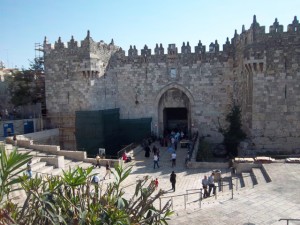
It didn’t help that I’d written the address down to show them, forgetting that my English spelling would be as meaningless to many of them as their Hebrew was to me. After much conferring among themselves, one driver finally agreed to take me, charging me what turned out to be double the normal fare. Although all week I’d encounter shopkeepers who were obviously adding a shekel or two foreigner’s tax to their usual prices, this was the only significant ripoff I experienced.
The hotel was located on a small hill overlooking the Old City and the Mount of Olives, and the neighborhood itself reminded me a bit of Tijuana, though considerably less menacing. But the terrain was similar, as was the haphazard mix of housing for both rich and poor, the auto repair shops, empty lots covered in trash, and a great, raucous, life-affirming din that ebbed and flowed but never completely subsided.
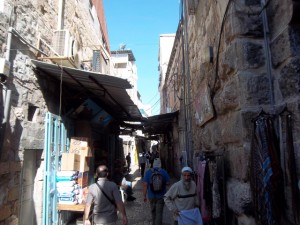
It was not a luxurious hotel by most measures, though efforts had been made, with judicious hangings of drapes and artwork and piped-in harp music, to soften the harsher aspects of its concrete construction. They helped a bit, but what helped even more was the extremely gracious and welcoming manner of Samir, the owner. Answering the same questions he must have fielded from thousands of nervous tourists – yes, the streets were perfectly safe to walk, even at night, yes, the mosque across the street did indeed broadcast prayers at deafening volume five times a day, the first at around 4:30 in the morning, but that was life in East Jerusalem – he exuded calm and patience, far more, I’m sure, than I’d be likely to show if strangers came questioning every aspect of life in my neighborhood and looking dubiously at me when I tried to assure them that they’d be just fine if they’d only relax and open their minds and hearts to what they were about to experience.
My room was not fancy, but it was large, and offered an equally large balcony overlooking the city. It was also situated so that the top of the minaret from which daily prayers were broadcast was at eye – and ear – level with me, a fact I was to learn to savor – albeit not completely – when funeral observance for a local dignitary commenced that evening, observances that were to comprise three solid hours of chanting for three consecutive nights.
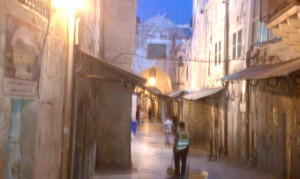
It was loud, really loud, and there was no escaping it, not even with all the windows closed – not an ideal situation anyway, with temperatures still hovering in the 80s – and earplugs in, but they stopped on the dot at 9:30 and were silent until the aforementioned 4:30 the following morning. At which point I was wide awake, and though (relative) silence reigned for the next few hours, there was no way I was getting back to sleep. Finally I gave up trying and wandered down the hill to the Old City, taking scrupulous note of each feature of the streetscape that I might use as a landmark to guide my way home.
I’d have been better off scattering breadcrumbs; as would happen again and again, I needed only turn a corner to find myself hopelessly lost, or at least hopelessly disoriented. In theory it’s not possible to get that “lost” in the heart of the city; it’s just not that large an area, and sooner or later you’ll turn a corner, spot the walls of the Old City walls in the distance, and congratulate yourself that you know – more or less – where you are after all. In reality, you’ll still be just as lost as you were before; you’ll just have a slightly better idea as to what part of town you’re lost in.
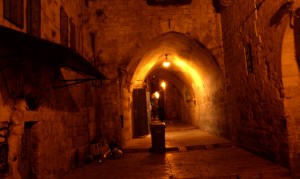
That goes double or triple for when you’re actually inside the Old City. You can walk across the entire thing in 20 minutes – in theory, anyway, provided you could find a street that goes in a straight line for more than a few hundred yards – and it’s almost impossible to wander away from it without noticing, since the only way in or out is through one of seven gates (there are four others, some dating back to Biblical times, that are currently sealed). Still, with or without a map, you’ll spend much of your time somewhat bewildered, which is probably the best way to take in the sights and sounds and smells. Even the gang of street kids who took it upon themselves to show me the way to a restaurant I was interested in, and who’d presumably lived there all their lives, found themselves befuddled at one or two of the maze-like passages and inexplicable dead ends.
A word about maps: I had several, none of which agreed with each other, and all of which were characterized by a degree of imprecision that you just wouldn’t expect to see in Western Europe or America. Part of the problem is the language: because of their unique alphabets, both Hebrew and Arabic have to be converted into their approximate equivalents in the Roman (i.e., the one we use) alphabet. Unfortunately, this process, formally known as transliteration, has no hard and fast rules, so you can get some pretty wide variations, especially when dealing with sounds that have no direct counterpart in English. As a result, the name of the road shown on your map may be distinctly different from the one on the street sign. If, in fact there is a street sign, and if, in fact, this particular street sign includes an English translation.
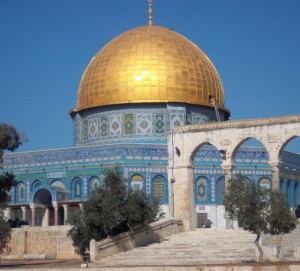
There seems to be a political aspect to street signs, as to most other things in Jerusalem: in the parts of the city that are firmly understood – inasmuch as anything is firmly understood – to be Israeli, street signs are generally rendered in Hebrew, Arabic and English. In the Christian Quarter of the Old City, you often see signs with only Arabic and English. And in East Jerusalem, where I was staying, there were many areas where you saw nothing but Arabic.
On the other hand, perhaps the non-standard language and the non-standard street signs simply reflected a larger reality that was beginning to dawn on me about the Middle East: that things are only occasionally, if ever, what they appear to be. I gave up expecting roads to be where the map said they were, and no longer bothered puzzling over why the major thoroughfare I was on didn’t seem to exist. Okay, so mapmakers and signmakers had a more flexible view of reality than I, with my linear and literal Western consciousness could embrace. But wait till you try getting a straight answer out of anyone with regard to when a certain building is open, or whether you can get to such-and-such place by bus, or how much something is likely to cost.
Oh, you’ll get answers all right, plenty of them, but they all boil down to: it’s open unless it’s closed, you can get to there by bus except if the bus isn’t running or doesn’t exist, and something costs whatever somebody says it does, even if the price tag says something totally different or he sold it to you yesterday for twice or half as much. With regard to the latter, I guess you’re supposed to bargain over the prices, that in fact many shopkeepers will feel let down if you simply hand over what they ask for, but I’ve never been much of a haggler, at least not a very successful one. I did find, however, that letting a cloud of sadness pass momentarily over my face or simply hesitating as if to wonder whether I could afford such munificent sum for a falafel would quickly result in a lower price being offered.

Where it really got frustrating, though, was when it came to seeing some of the places I’d most anticipated visiting. Case in point, the Al-Aqsa mosque. I heard so many versions of when or if non-Muslims were allowed inside that it was making my head spin, but I thought I’d finally figured out that they were, provided you got there early enough, between 7:30 and 11 am, or between 7 and 10:30, again depending on who you listened to. So I dragged myself out of bed earlier than usual, came down into the hotel lobby to discover another surprise: not the breakfast buffet I was expecting, but about three dozen Arabs in robes and headdresses having some sort of confab of their own and who looked at me curiously, as though it had never occurred to them that they might encounter a foreign guest in a hotel.
I deduced but never confirmed that the hotel must be offering parallel breakfasts, one for locals beginning around 6 am and another for the tourists at 7:30 or 8. Which was quite different from what I could have sworn I’d been told when checking in, but I’d been there long enough by now that I was becoming adept at the accepting shrug, so off I went to the Old City, walking along the eastern and southern walls and entering through the perhaps unfortunately named Dung Gate (I normally entered through the rather low-key Herod’s Gate, which led directly into the Muslim Quarter, but by week’s end I’d traversed them all).
Despite the early hour, there was a long line of tourists waiting to pass through the metal detector (and to be inspected for exposed body parts that Allah and/or the guards might deem immodest), but it moved quickly, especially once the line split in two (women and men have to enter separately; the same is true for the approach to the Western Wall, situated directly below the Muslim shrines of Al-Aqsa and the Dome of the Rock. I’d been told I had to buy a ticket that would allow me entry to both mosques and the Islamic Museum, but true to form, I passed onto the Temple Mount (as Jews would have it; the Muslims call it the Noble Sanctuary) without being asked for tickets or money.
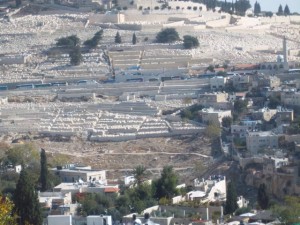
It’s a spectacular setting, the two mosques set apart from each other in the midst of a vast courtyard that afforded views over the entire city and the surrounding mountains. From an external standpoint, the Dome of the Rock (named for a rock on which Muhammad himself apparently stood) is more striking, but I found myself drawn to the older and somewhat plainer Al-Aqsa. People were entering and leaving the building, but as I approached the guard who’d been dozing in a chair near the door snapped to life and barked, “Only Muslims!”
Well, I asked, when might I, as a non-Muslim, be allowed in? “Never! Only Muslims!”
To give the man his due, these seemed to be the only English words he knew, and I doubt if he understood anything else I asked him. A guide who was touting for business nearby pointed me in the direction of a kiosk where I could allegedly buy a ticket to enter the mosque, but all I found was a gateway leading into a colorful street market. A man stood there with a fistful of dollars, barring my way. “Five dollars!” he demanded. Most of the tourists simply handed over the money, but I thought it best to inquire what I’d be paying for (I didn’t have any dollars on me, anyway, only Israeli shekels).
“Exit! Five dollars! You pay me!”
“But I don’t want to exit, I just got here.”
“Okay, four dollars!”
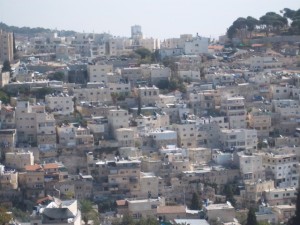
I shrugged (I was getting pretty good at it by now) and walked back to the mosque, where, though the guard eyed me suspiciously, I was able to sneak peeks at the interior as worshipers came and went, occasionally leaving the door open until someone, noticing that I was looking inside, pointedly closed it again. Two things struck me: the incredible color and texture of the light, like that of liquid rubies raining down from heaven, and the scent of the incense, like nothing I’d ever smelled before but which also, for reasons I can’t put a finger on, evoked the richness of rubies, and almost spurred me to make a mad dash for the door so that I might spend at least a moment or two inside before I was gunned down. Which I very possibly would have been; ever since a crazed Australian Christian tried to firebomb the place in hopes of speeding up the Apocalypse, Muslims have understandably been very touchy about infidels approaching too closely.
That was hardly the only incident to raise Muslim hackles; some Jews, especially those from more extreme sects, are convinced that not only do Al Aqsa and the Dome of the Rock sit on the site once occupied by the original Temple of Solomon, but that it is incumbent on them to build a new Temple there. Even if such a thing could be accomplished without disturbing the existing mosques, the Muslims consider the entire area, indoors and out, to be part of the Noble Sanctuary. As things currently stand, in order to keep the peace, Jews – and other non-Muslims as well – are not allowed to pray in any visible manner while on the grounds.
That hasn’t stopped groups of hardcore Zionists from periodically attempting to sneak or force their way into the Sanctuary to either symbolically or physically lay the groundwork for a new Temple. Ariel Sharon led one such delegation to the doors of Al-Aqsa in 2000, setting off the Second Intifada and propelling him into power as Prime Minister. Thankfully no such antics were in evidence while I was there, and the biggest threat to peace and sanity involved herds of tourists milling about snapping photos of each other.
I talked about this with Samir back at the hotel that night, and while he agreed with me that non-Muslims should be welcomed into the mosques so long as they didn’t interfere with prayers and services, he helped put things in perspective, pointing out the fear, paranoia, suspicion and intolerance that continued to bubble just beneath the surface of a momentarily tranquil city and country. From what I knew of his history, I imagined he must have experienced some hard times; I didn’t ask his age, but I guessed he might be just about old enough to have been around when Israeli troops first swept into East Jerusalem and occupied it during the 1967 war. That’s got to have an impact on a kid, right?
And yet Samir was as even-handed and open-minded a person as I would meet during my travels. It wasn’t as though he was completely uncritical; he could and would point out flaws in the reasoning and behavior of the various religions and factions, but he would quickly balance them with insights into why the people involved might think or act that way. Being that he regularly had to travel through the notoriously difficult Israeli checkpoints to visit family and friends, I expected him to harbor some resentment about the treatment routinely directed toward Palestinians and Arabs, but if he did, there was no sign of it; instead, he calmly described the easiest ways and times to cross into and back from the West Bank.
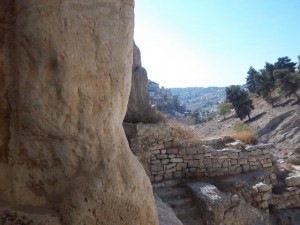
Perhaps his easy-going acceptance of an unhappy situation could be ascribed mainly to his role as a hotel-keeper; it’s not the sort of job where you want to risk alienating guests with controversial opinions. But his attitude seemed to be shared by the majority of East Jerusalemites I met: it wasn’t that they were happy with the situation, but had nonetheless found a way of living with it. Increasingly, I found myself feeling more at home in the Arab neighborhoods; the overwhelming foreignness that had struck me at first was still there, but it was becoming a familiar, comforting foreignness as well, helped by the common practice of being told “Welcome” by every other person I passed on the streets.
Only a few times did passersby attempt to engage me in more substantial conversations, whether because they had nothing else to say or because it was all the English they knew, but that simple “Welcome” did the trick, made me feel appreciated for no other reason than the fact that I was there. Nobody was trying to sell me anything or push any kind of agenda on me. The ones most able and ready to talk at greater length were the kids, often no more than 12 years old, who not only seemed more adept at English, but were also genuinely curious about where I was from and what I was doing in East Jerusalem.

It felt very different in the Israeli neighborhoods of West Jerusalem. Some of them were very pleasant and cosmopolitan, offering an only somewhat Orientalized take on the boulevards and high streets you’d find in Paris, London or Berlin; others, as one local commentator sourly said, resembled “a 13th century Polish shtetl.” He was referring to Me’a She’arim, a Charedi, or Ultra-Orthodox enclave in Northwest Jerusalem, which has gained notoriety for its hostility, sometimes expressed violently, toward outsiders who wander into the neighborhood in insufficiently modest dress or who violate the Sabbath by, for example, taking photos or talking on cell phones.
The Charedim are the fastest growing sect of Judaism, and wield power out of proportion to their numbers because of the nature of Israeli politics: the relative handful of representatives they elect to the Knesset often decide which of the two major parties will be able to form a government, and they have been able to exact a substantial price for their support. One of the stress points in Israeli society is where and how the Charedim should fit in: as it stands now, they are exempt from military service, seldom seek work outside their own community, and their children attend yeshivas (theological schools) rather than ordinary high schools or colleges, leaving them poorly equipped to participate in the modern Israeli economy, and thus frequently dependent on government assistance.

There’s considerable concern about the divisive effects of the Charedim on Israeli society, but few politicians dare to publicly criticize or question them. What’s more, despite the outrage felt by many liberal or secular Jews at what they see the Charedim “getting away with,” there’s a countervailing tendency that results from the siege mentality that still affects Israelis even after 60 years of ascendancy: the sense that, “Well, we may not like everything about them, but they’re still family when you get down to it.”
Sitting at a sidewalk cafe in a fashionable neighborhood not far from the homes of both the President and Prime Minister, I talked with several such liberals, the sort that Chaim back in Tel Aviv would have scorned as “worse than atheists,” and found them straddling an uncomfortable dichotomy as best they could: devoutly religious by their own, if not Chaim’s standards, they also shared the sensibilities we’d associate with liberals and civil rights advocates here in the West. One of them, in particular, told me about working in a clinic where over the years she’d delivered hundreds of babies, both Arab and Jewish, and how in the course of doing so, had become semi-fluent in Arabic and familiar with Arabic customs.
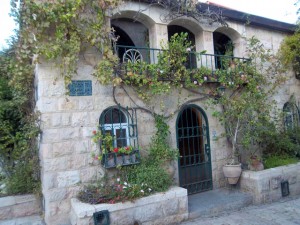
She seemed to have a genuine sympathy for the people she’d worked with, so I asked her a question that had been bewildering me. Jerusalem, I’d noticed, was highly segregated, especially when it came to housing. How was that maintained, I wondered, and what would happen if an Arab tried to rent or buy a house in West Jerusalem or a Jew did the same in the East?
“Well, some Jews have moved into East Jerusalem,” she said, “but it’s generally seen as a provocation if they do. I’d say that unless they go in with a group and more or less barricade themselves off from the rest of the area, they’re not going to have too happy a time.”
And an Arab who wanted to move into West Jerusalem?
“Again, there are some areas – not many – that are integrated, but I think most Arabs would have a very hard time finding a property owner willing to sell or rent to them.”
Her voice seemed tinged with regret at this state of affairs, and I thought perhaps I had found a kindred soul. But my illusions were quickly dashed when I wondered aloud if or when hardline Prime Minister Benjamin Netanyahu might set some limits on the Israeli settlements that were threatening to derail the latest negotiations toward a peace treaty with the Palestinians.
“Oh, I don’t think Bibi (Netanyahu’s nickname) is hardline at all,” she said. “If anything, I’m afraid he’ll give up too much too easily. Like Sharon: we thought he would always stand strong for Israel, but then he gave away Gaza, and what did we get in return? Nothing, nothing at all. It’s still a scar on the heart of Israel, the sight of those settlers being dragged out of their homes by their own countrymen. And Gaza itself? A great, festering sore, a nightmare for the people trapped inside and a menace to all Israelis unfortunate enough to live nearby.”
To be continued
